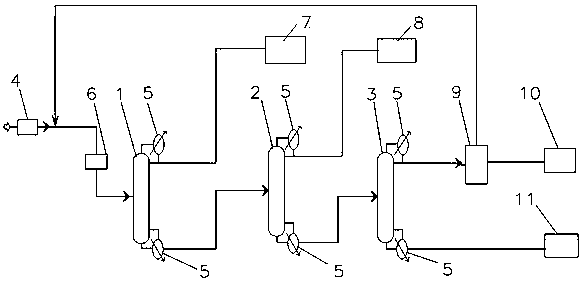Method for separating and recycling naphthalene residual oil
A technology for separation and recovery of residual oil, applied in crystallization purification/separation, chemical instruments and methods, purification/separation of hydrocarbons, etc., can solve problems such as increasing the cost of tail gas desulfurization, easy to pollute the environment, and increasing the sulfur concentration of carbon black tail gas , to achieve the effective utilization of resources and increase the content of naphthalene
- Summary
- Abstract
- Description
- Claims
- Application Information
AI Technical Summary
Problems solved by technology
Method used
Image
Examples
Embodiment 1
[0023] Such as figure 1 as shown,
[0024] A method for separating and recovering naphthalene residual oil, comprising the following steps carried out in sequence:
[0025] Feed: adjust the pressure of raw naphthalene residual oil at 15kPa through the feed pump, and the mass flow rate is 859kg / hr. After mixing with the crystallization mother liquor through a mixer, send it to the light removal tower. The temperature of the mixed liquor is 47.9°C;
[0026] Light removal: keep the temperature of the light removal tower at 130-170°C, and separate the light components in the raw naphthalene residual oil. After separation, the light gas phase components at the top of the tower are condensed and sent to the condensate tank, and the liquid in the condensation tank is refluxed A part of the pump is sent to the top of the tower as reflux, and the other part is sent to the light component storage tank as a by-product; the material discharged from the bottom of the light removal tower i...
Embodiment 2
[0040] A method for separating and recovering naphthalene residual oil, comprising the following steps carried out in sequence:
[0041] Feed: Raw naphthalene residual oil passes through the feed pump, mixes with the crystallization mother liquor through a mixer, and then sends it to the light removal tower. The temperature of the mixed liquor is 60°C;
[0042] Light removal: keep the temperature of the light removal tower at 130-170°C, and separate the light components in the raw naphthalene residual oil. After separation, the light gas phase components at the top of the tower are condensed and sent to the condensate tank, and the liquid in the condensation tank is refluxed A part of the pump is sent to the top of the tower as reflux, and the other part is sent to the light component storage tank as a by-product; the material discharged from the bottom of the light removal tower is sent to the naphthalene removal tower;
[0043] Naphthalene removal: Keep the temperature of th...
Embodiment 3
[0052] A method for separating and recovering naphthalene residual oil, comprising the following steps carried out in sequence:
[0053] Feed: Raw naphthalene residual oil passes through the feed pump, mixes with the crystallization mother liquor through a mixer, and then sends it to the light removal tower. The temperature of the mixed liquor is 40°C;
[0054] Light removal: keep the temperature of the light removal tower at 130-170°C, and separate the light components in the raw naphthalene residual oil. After separation, the light gas phase components at the top of the tower are condensed and sent to the condensate tank, and the liquid in the condensation tank is refluxed A part of the pump is sent to the top of the tower as reflux, and the other part is sent to the light component storage tank as a by-product; the material discharged from the bottom of the light removal tower is sent to the naphthalene removal tower;
[0055] Naphthalene removal: Keep the temperature of th...
PUM
 Login to View More
Login to View More Abstract
Description
Claims
Application Information
 Login to View More
Login to View More - R&D
- Intellectual Property
- Life Sciences
- Materials
- Tech Scout
- Unparalleled Data Quality
- Higher Quality Content
- 60% Fewer Hallucinations
Browse by: Latest US Patents, China's latest patents, Technical Efficacy Thesaurus, Application Domain, Technology Topic, Popular Technical Reports.
© 2025 PatSnap. All rights reserved.Legal|Privacy policy|Modern Slavery Act Transparency Statement|Sitemap|About US| Contact US: help@patsnap.com

